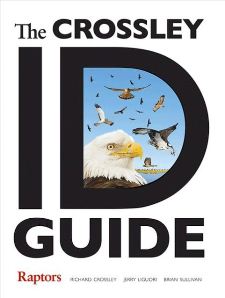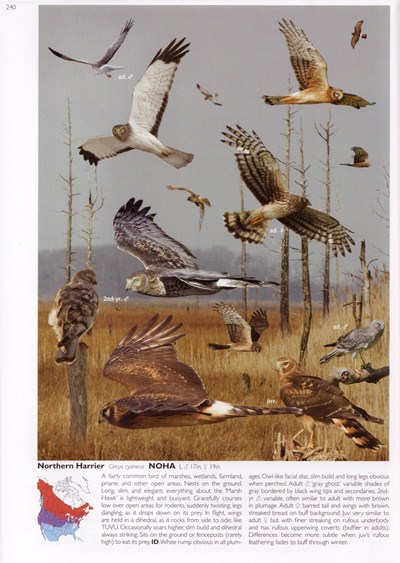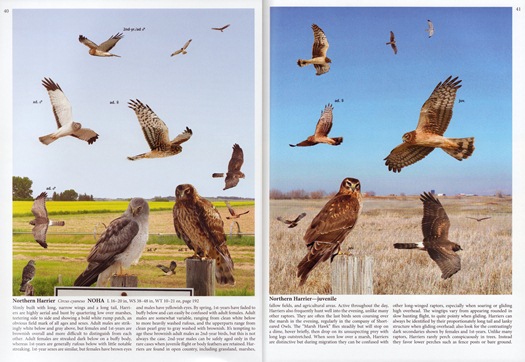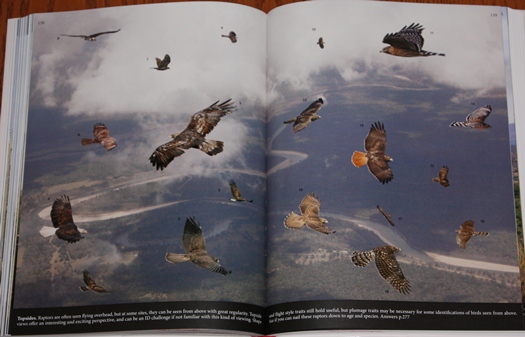Reviewed by Grant McCreary on June 23rd, 2013.
I love specialized identification guides as reference material, as something used to work out a puzzle after the fact. But I have a confession: it has always been hard for me to study them as preparation. Page after page of photographs and, I just can’t help it, my eyes start to glaze over. But that hasn’t happened with The Crossley ID Guide: Raptors. This guide, although it includes more images of raptors than any similar book on the market, really draws you in. Open it up and the reasons why become obvious very quickly.
The first reason is Crossley’s unique plate designs, which he introduced in his Eastern birds guide. He takes an appropriate background photo for the given bird and then digitally incorporates (aka “photoshops”) multiple images of the bird onto the background. This method does a wonderful job of showing birds how they actually look in life, from different angles, lighting, and distances. But they are also really busy. Each species was shown, at most, on a single, entire page. But that one photo would contain anywhere from a dozen (most songbirds) to hundreds (waterfowl) of birds. Here’s an example from the Eastern guide.
But overall, I thought the raptor plates in Crossley’s Eastern book were really good. So I was very curious how they would work in this family-specific guide. I was pleased to find many more plates than I had been anticipating. Basically, Crossley stuck with the same basic design but greatly expanded upon it. For example, instead of a single page, the Northern Harrier now gets four.
While a few birds get fewer pages – most of the range-restricted raptors two pages and Aplomado Falcon just one – many have even more. Red-tailed Hawk has ten! Spreading out over more plates means fewer images had to be crammed in, which makes the plates of this raptor guide much less busy and more pleasurable to examine.
The added space also gives Crossley the freedom to include more than can normally be illustrated in traditional field guides, such as cool behavior. For example, there is a fantastic two-page spread that shows, in a series of images, a Snail Kite plucking a snail from the water.
The second reason The Crossley ID Guide: Raptors is so engaging is its use of mystery photos. There are 32 (!) plates, all but one dual-paged, where the birds are not labeled but numbered. The identifications are revealed in an appendix, along with some brief notes. Most of these plates group different species, such as “Widespread Eastern Raptors” and “Buteos on the Midwest Prairie”. The rest let you practice ageing a single species. You’ll have so much fun pouring over these plates you won’t realize how much you’re learning!
Text
You may not notice it at first, busy as you’ll undoubtedly be ogling the pictures (not that I’d blame you), but The Crossley ID Guide: Raptors contains a good bit of text, most of it written by Liguori and Sullivan. Underneath each plate is an overview of identification features, habits, and range. After soaking in the image, you’d be well advised to read the accompanying text. Full accounts, along with range maps, can be found in the second half of the book.
The accounts, which average about three pages each, cover:
- Opening – see below
- Overview – general notes
- Flight Style
- Size and Shape – including measurements (in both metric and imperial!) and some useful descriptions
- Plumage – clearly broken down by age and morph
- Geographic Variation – subspecies and other geographic differences
- Molt
- Similar Species
- Hybrids
- Status and Distribution
- Migration
- Vocalizations
The accounts are useful and very readable. But perhaps the best thing about them is the opening section, in which Crossley urged his fellow authors to “think outside the box and ‘be the bird’”. These are short vignettes in which Liguori and Sullivan seek to convey the personality of the bird or the feeling of encountering one. In some they even write from the bird’s perspective. Overall, these introductions work pretty well and I’ve enjoyed just flipping through and reading them. They are a very nice departure from the usual identification-book fare. However, the first-bird, so to speak, stories aren’t nearly as good as Pete Dunne’s similar efforts in The Wind Masters.
Recommendation
Apart from spending significant amounts of time alongside an experienced hawk watcher in the field, The Crossley ID Guide: Raptors is the easiest and most fun way to learn raptors. I’d recommend it to any birder.
If you’d like to see how Crossley stacks up against other raptor guides, see Raptor Books – A Comparison of North American Field Guides
Disclosure: I get a small commission for purchases made through links in this post.
Buy from NHBS
(based in the U.K.)
Disclosure: The item reviewed here was a complementary review copy provided by the publisher. But the opinion expressed here is my own, it has not been influenced in any way.









Comment